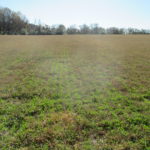Interseeding Alfalfa Into Bermudagrass
go.ncsu.edu/readext?515402
en Español / em Português
El inglés es el idioma de control de esta página. En la medida en que haya algún conflicto entre la traducción al inglés y la traducción, el inglés prevalece.
Al hacer clic en el enlace de traducción se activa un servicio de traducción gratuito para convertir la página al español. Al igual que con cualquier traducción por Internet, la conversión no es sensible al contexto y puede que no traduzca el texto en su significado original. NC State Extension no garantiza la exactitud del texto traducido. Por favor, tenga en cuenta que algunas aplicaciones y/o servicios pueden no funcionar como se espera cuando se traducen.
Português
Inglês é o idioma de controle desta página. Na medida que haja algum conflito entre o texto original em Inglês e a tradução, o Inglês prevalece.
Ao clicar no link de tradução, um serviço gratuito de tradução será ativado para converter a página para o Português. Como em qualquer tradução pela internet, a conversão não é sensivel ao contexto e pode não ocorrer a tradução para o significado orginal. O serviço de Extensão da Carolina do Norte (NC State Extension) não garante a exatidão do texto traduzido. Por favor, observe que algumas funções ou serviços podem não funcionar como esperado após a tradução.
English
English is the controlling language of this page. To the extent there is any conflict between the English text and the translation, English controls.
Clicking on the translation link activates a free translation service to convert the page to Spanish. As with any Internet translation, the conversion is not context-sensitive and may not translate the text to its original meaning. NC State Extension does not guarantee the accuracy of the translated text. Please note that some applications and/or services may not function as expected when translated.
Collapse ▲Extension agents from Johnston, Harnett, Wake, and Sampson counties recently planted demonstration plots in each respective county to see if alfalfa can be successfully grown interseeded with bermuda in our area. Each of these counties already have producers who are successfully growing alfalfa in pure stands. It will be interesting to see what we will learn from these demonstration plots!


- Possible benefits from interseeding alfalfa into bermudagrass
Alfalfa allows producers to grow their own nitrogen. - Alfalfa and bermudagrass results in forage that is 30 to 40 or more relative feed points higher than bermudagrass alone.
- The Bermuda component should help the alfalfa dry faster, retain more leaves, and minimize ash content from soil contamination.
- When the alfalfa plays out over several years the bermudagrass should still be there and able to reclaim is dominance.
Best management practices for establishing alfalfa into bermudagrass
- First select an appropriate site for planting. Make sure the alfalfa is being planted on a good well drained soil that is not too sandy. The soil pH needs to be 6.5 or greater or don’t try it. Also alfalfa needs lots of (P) phosphorus and (k) potassium fertility in the soil. Also, make sure that there are no herbicide residuals, read the product labels of materials that have been used for guidance on when alfalfa can be planted safely
- Test soil at the site; apply lime to ensure a pH of 6.5 or greater at the time of planting. Fertilize according to soil test recommendations and apply boron and molybdenum if needed.
- Plant at the right time of the year. In the Coastal Plain the best dates for planting appear to be Sept 1- October 15. Be sure that soil moisture is good and insects are not prevalent before planting.
- Clip or graze the bermudagrass short (1 – 2” inches) prior to planting.
- Spray the field with a light rate of a non-selective herbicide to “Chemically Frost” the bermudagrass. This will help prevent bermuda from growing back and competing with the seedling alfalfa. (Paraquat at 1qt/acre or Roundup at 9oz/acre of 5.5 lb. a.i. formulation or 12oz/acre of 4 lb. a..i. formulation). Ok to burn off thatch after chemical burndown before planting.
- Select alfalfa variety with a dormancy rating of 4-6 with disease resistance greater than or equal to MR for phytophthora root rot (PRR), anthracnose (An), bacterial wilt (Bw) and fusarium wilt (Fw) as well as an R rating to aphanomyces root rot (APH). Drill 22 to 25 pounds per acre if planting into 7 to 9 inch rows or 11 to 13 pounds per acre if planting into 15 inch rows. Seed depth should be a quarter to half inch deep.
- After the alfalfa comes up spray with an inexpensive insecticide (such as one of the synthetic pyrethroids, ex. Karate or Mustang Max at highest labeled rates) to control insect pests. Irrigate if available and necessary.
Maintenance
Apply K as recommended, same rates as for bermudagrass. Also apply B and Mo as recommended (for nodulation). Tissue sample 1 week before second cutting each year. Be on the lookout for insect pests. During February and March scout and spray fields for alfalfa weevils and during summer for fall armyworms if needed.
A good video on this subject, Why Interseed Alfalfa into Bermudagrass form the University of Georgia.
References
Dennis Hancock, Extension Specialist University of Georgia. Progressive Forage Grower. June 2015. Why Interseed Alfalfa into Bermudagrass UGA Cooperative Extension



